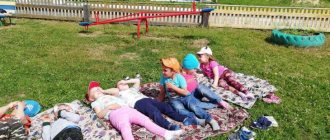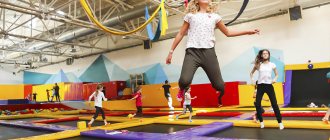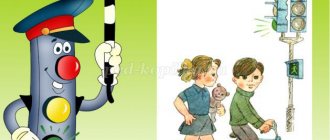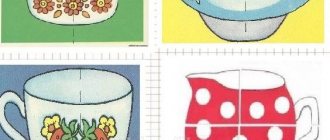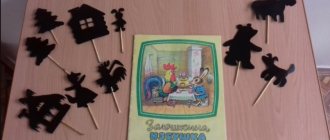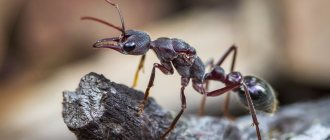Summer sports events and entertainmentmethodological development on the topic
Summer sports festival "Robinson's Journey"
Goals:
instilling in children a responsible attitude towards the environment and the ability to follow environmental rules; expansion of ecologically valuable contacts with objects of living and inanimate nature.
Equipment:
an hourglass, a map of the Robinsons' hiking route, necessary items for various situations on a hike; attributes for games, natural material for building a hut; food supplies, medicines.
Characters
- Leading.
- Chief Robinson.
- Old forest man.
- Forest Fairy.
- Friday.
- Children are little Robinsons.
Holiday scenario
The holiday is held on the territory of the kindergarten.
Children of older groups gather on the sports ground.
Educator. Guys, are you all familiar with Robinson? What happened to him? Yes, he ended up on a desert island and all sorts of adventures happened to him. Life without adventure is uninteresting. Do you want fun adventures? Let's play Robinson and go hiking. To do this, you need to turn into Robinsons. So, we cast a magic spell (close our eyes).
One, two, three - turn around,
Turn into Robinsons.
Children repeat several times.
Educator. Look how many Robinsons there are! Who will lead us on the hike? We need a Chief Robinson.
Robinson. And I’m already here, I’m so glad that you have so many adventure lovers. So let's be friends and rejoice together.
Robinson. Look at the hours. This is an hourglass. Even ancient people used them (Check the time.). What will we take with us on a hike?
From the laid out items, children choose a magnifying glass and equipment for games.
Educator. What kind of package is this? Oh, you and I are just lucky! We will travel along a map that shows Robinson's travel route.
They remember all the rules of human behavior in nature, everyone makes a fire together, puts supplies in the pot, and leaves Robinson in charge for cooking.
Educator. Is everyone ready? Let's hit the road. We walk together, single file, and there are dangers on the untrodden paths. Be extremely careful.
Educator. Look, the trace of some unknown beast. Maybe it's Bigfoot?! No, it’s warm in these parts. Who could it be?
(They approach the “forest.”)
The Old Forest Man comes out to meet the travelers.
Old forest man. What's that noise in my forest?
I hear the cracking of branches.
Who broke the silence?
I'm better off here without you.
Robinson. So this is whose traces there were. We are greeted unkindly by the Old Forest Man. Behave well in the forest, maybe he will become more gentle.
Old forest man. Who are you, good or evil?
Robinson. We are travelers and will not commit evil in your forest.
Old forest man. Do you know how to behave here?
Children tell the rules of human behavior in the forest.
Old forest man. Now I see that you are good people. I allow you to inspect my property. Do you know the inhabitants of the forest? For example, what kind of birds are these?
Children recognize birds from the illustrations. The old forest man calls for protecting the birds and awards the winner the title “Bird Expert.”
Robinson. Let's learn to move carefully through the forest so as not to alarm the birds.
Game "Sneak up".
An adult (teacher) portrays a fox, children – birds. The fox is hiding behind a stump, her eyes are hidden. A calm melody sounds, the children silently, on tiptoes, creep up to the fox, trying to pass by it or around it so as not to be detected. If the fox “smelled and felt” the bird, she catches it and “hides” it in her hole.
Robinson. Look how many cones there are in the forest. In order to continue the path, you still need to practice your dexterity.
Game "Hit the Target".
The players are given cones (equal amounts). At a certain distance, a target is placed in front of each player - a basket or basket. The players' task is to hit the target and throw all the cones into the basket. The one who has the most accurate hits wins - more cones in the basket.
Old forest man. You must always be careful on the road. I'll check it now. Here are the squirrels sitting, see? They love to dress up and tie colorful ribbons on their tails. Help them dress up - decorate their ponytails in an unusual, original, bright way.
Game "Squirrel tails". Squirrel girls tie bows on their hair.
Robinson. Thank you, Old Forest Man, for your hospitality. Time is running. We need to move on.
Robinson. The forest is not over yet, look - there is a clearing. Maybe we can rest a little. (They sit on the grass.) Oh-oh, so many beautiful butterflies! Remember the forest commandments: “You cannot catch butterflies!”
Game with hoops.
A cheerful moving melody sounds. The children are located opposite each other at a distance of 5–6 m. One has a hoop in his hands, which he rolls to the player opposite. While the hoop is rolling, the “butterfly” child tries to “fly” into it as many times as possible without hitting or dropping it. The team whose hoop rolls from start to finish, and whose “butterfly” flies through it more often than others, wins.
The Fairy of the Forest comes into the clearing.
Robinson. We were spotted again. Who are you, beauty?
Fairy. I am the Fairy of the Forest. I love everything beautiful. That's why I live close to flowers. Do you know forest flowers? How wonderful it is in the forest! A cool breeze is blowing. The trees whisper their forest tales. Do you know what trees are surrounded by bushes? Which ones did you meet along the way?
Children also name fruit trees.
Robinson. Tell me, what kind of dimples are there on the paths?
Fairy. These forest animals make a shelter for themselves - they will hide in a hole to be unnoticed, wait out the danger and then run on. Birds use dimples to build a nest in the recess.
Game "Dimples".
At some distance from each other, brown cardboard circles are laid out across the group’s territory - these are “dimples in the forest.” At the teacher’s command “Start,” the children begin jumping over the dimples. At the teacher’s command “Hide”, they must stop in the “hole”, frozen in the position in which the team found them, and hold out in the “hole” until the teacher’s new command.
Robinson. We have ropes with us. We have not yet found a place where we can collect branches with which we will tie bundles of brushwood. So let's play with these strings.
Game "Wind the string".
Two guys stand opposite each other, a rope is stretched between them, a rack is attached to the ends, and a bow is tied in the middle. Whichever child winds the rope into a bow the fastest will win the game.
Fairy. You are all cheerful, and I wish you a happy journey!
Robinson says goodbye to the Fairy and moves on.
Robinson. Oh, what a big rope! We can use it to cross the river if we suddenly meet it on the way. I suggest you try it.
Game "Don't fall into the river"
(children must carefully step on the rope so as not to fall “into the river”).
Robinson. We need to hurry.
Friday appears.
Friday (surprised that he sees many Robinsons). Robinson! Robinson! I'm Friday! I lost Robinson!
Robinson. I see, friends, that you are a little sad. Maybe we can have some food to lift our spirits? Now our tourist lunch is probably ready. I smell delicious smells. We are all preparing our tummies for food.
Children are treated to sweets. The holiday ends.
Scenario for the summer name day holiday
While staying at a summer health camp, there are birthday children among the children who must be congratulated on their birthday. This is very important, because a birthday is a grand holiday for every child. And if he is away from his family and gifts, this day becomes doubly special.
Each counselor knows all the kids in his troop, and once or twice a week he organizes parties to mark their name days. The number of name day holidays is regulated by the camp charter. In large camps they are celebrated every day.
Either the entire squad takes part in the celebration, or the celebration is organized for all the birthday people of the camp. Here, too, everything depends on the camp regulations.
Let's look at what a summer holiday - a name day - can be using the example of a prepared scenario.
Scenario for a summer holiday at a preschool educational institution
With the arrival of summer warmth comes the most fruitful days for activities with children. This is the best time for group work outdoors. Teachers have an excellent opportunity to prepare and conduct sports, artistic and aesthetic activities with children, for example, drawing, modeling, appliqué, and crafts from collected natural materials.
In addition, you can have conversations on the playground and watch nature. All these events awaken children's interest in the flora and fauna, increase the desire to create, to convey the beauty of what they see in drawing, modeling, and appliqué.
The cognitive sphere is considered one of the important points in planning children's events. After all, little children are young explorers who are interested and fascinated by everything. For children's holiday events, summer time is perfect. After all, it is in the summer that there are so many fresh fruits and flowers, which are extremely necessary for organizing holidays.
In addition to having fun, holiday events teach children interaction, respect, and mutual assistance. Games, songs, dances, and competitions help children make friends and feel important and irreplaceable. This is very important, because children in early preschool age are just beginning to form, they urgently need communication and interaction, a sense of team.
Everything that is instilled in them in a junior preschool institution, they will carry with them throughout their lives. The attitude at school and other educational institutions depends on the atmosphere and holiday in the kindergarten. Therefore, educators are faced with the task of helping children open up. The main tool for this is precisely a children's party.
Let's look at what a summer holiday could be like in a preschool educational institution using the example of a prepared scenario.
Physical development in preschool
Children's fitness is a system of activities aimed at strengthening and maintaining the health of children.
The use of fitness movements in kindergarten not only fuels interest in sports activities and teaches them to enjoy physical activity, but also improves health. Children learn to understand and control their bodies. They develop muscle strength and body plasticity, acquire correct posture and a harmonious physique.
Sports activities in kindergarten not only develop children physically, but also have a beneficial effect on their psychomotor state. Kindergarten children develop harmoniously physically, spiritually and aesthetically.
Fitness goals in kindergarten
Physical activity contributes to the development of many qualities of a child. This includes the development of motor skills, high performance, and successful mastery of new material.
Outdoor games and physical exercise have a beneficial effect on processes such as memory, attention, imagination and thinking. Sport not only develops, but also disciplines and gives self-confidence.
At the same time, physical education can help children of different temperaments:
- passive guys will be able to open up to new energies, increasing their vitality;
- hyperactive kindergarteners will learn to harmoniously distribute their energy costs;
- capricious children will be able to feel the strength of their body and become more resilient.
It is all these problems that fitness for children is designed to solve.
If we take a separate kindergarten, then the main tasks of fitness in a preschool institution are:
- Formation and improvement of children’s physical qualities (endurance, coordination, strength, agility, speed)
- Prevention of disorders in the musculoskeletal system
- Introduction to healthy lifestyle and sports
These tasks are specified based on the age group of the children.
Fitness club program for different age groups
Children's fitness involves achieving different tasks in different kindergarten groups. The main ones are listed in the table.
| For whom | Tasks |
| For the younger group |
|
| For the middle group |
|
| For older kindergarteners |
|
Important! It is recommended to devote 2-3 times a week to sports activities in kindergarten, one of which would be outside.
How to organize children's outdoor sports activities is shown in the video:
.
